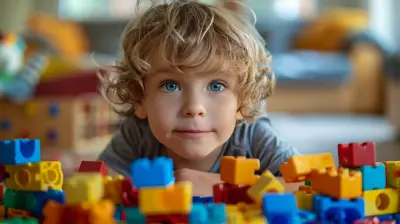9 April 2025
Blended families are beautiful, but let’s be real—they come with their own set of challenges. Merging two different family units means navigating complicated emotions, shifting dynamics, and the tricky task of building trust. One of the most critical aspects in making a blended family work is nurturing secure attachment between parents, stepparents, and children.
So, how do you create a strong emotional foundation when past relationships, histories, and insecurities are at play? Let’s break it down step by step.

Understanding Secure Attachment
Before we jump into actionable steps, let's clarify what secure attachment actually is. Secure attachment is the kind of emotional bond that makes kids (and adults) feel safe, valued, and understood. It develops when caregivers provide consistent love, attention, and support.In a blended family, this means making sure that every child—whether biological or step—feels emotionally grounded and confident in their place within the family.
Why Is Secure Attachment So Important?
A child with secure attachment:- Feels safe expressing emotions
- Trusts caregivers and forms healthy relationships
- Develops strong self-esteem
- Handles life’s ups and downs more effectively
On the flip side, when kids don’t feel securely attached, they may struggle with trust issues, anxiety, or behavioral challenges. This is why focusing on attachment in blended families is non-negotiable. 
Challenges of Attachment in Blended Families
Let’s be honest—blended families don’t form overnight. Kids may be dealing with grief from a divorce, lingering resentment, or just uncertainty about their new family setup. Here are some common obstacles:1. Divided Loyalties
Children sometimes feel guilty about loving a stepparent because they fear they’re betraying their biological parent.2. Fear of Rejection
Stepparents may feel unwanted, while kids may worry about being "less important" to their biological parent now that a new family is in the picture.3. Different Parenting Styles
Each parent may have their own approach to discipline, affection, and routines, which can create confusion and tension.4. Emotional Baggage
Past trauma, divorce-related stress, or unresolved conflicts can make it difficult for children to trust new authority figures.Understanding these challenges is the first step toward overcoming them. Now, let’s get into how to build secure attachment in a blended family. 
How to Foster Secure Attachment in a Blended Family
1. Build Trust Through Consistency
Trust is the foundation of secure attachment. When kids know what to expect, they feel safe.- Stick to routines—whether it’s bedtime, meal times, or family traditions.
- Follow through on promises. If you say you’ll be at their soccer game, be there.
- Be patient. Trust isn’t automatic; it’s built over time through consistent actions.
2. Create a Judgment-Free Emotional Space
Kids need to feel like they can talk about their emotions without fear of being criticized or dismissed.- Validate their feelings: “I can see why that would be frustrating.”
- Avoid comparing them to their step-siblings. Every child’s experience is unique.
- Don’t take things personally. If they lash out, it’s often a reflection of their inner turmoil—not something you did wrong.
3. Let Relationships Develop Naturally
One of the biggest mistakes stepparents make is forcing a close relationship too quickly. Kids need time to warm up.- Instead of trying to be the “cool” stepparent instantly, start with small positive interactions—playing a game together, watching their favorite show, or simply asking about their day.
- Respect their boundaries. If they need space, give it to them.
- Show up consistently without demanding affection—love is earned, not commanded.
4. Encourage One-on-One Time
Blended families are often big and busy, which can make kids feel overlooked. Carving out one-on-one time can make a world of difference.- Biological parents should have solo time with their kids, so they don’t feel like they’ve been “replaced.”
- Stepparents should also find low-pressure ways to bond—maybe a shared hobby or a special outing.
5. Communicate Openly (But Age-Appropriately)
Honest communication is key, but it’s important to tailor your discussions to the child’s age.- Young children need reassurance: “You’re loved, and we’re all in this together.”
- Teens need more autonomy: Instead of dictating, ask for their input on family decisions when possible.
- Encourage family meetings where everyone can express their feelings in a safe and structured way.
6. Support and Accept Different Coping Timelines
Not every child will adjust at the same pace. Some might embrace the new family quickly, while others may struggle for years.- Don’t rush the process. Healing and attachment take time.
- Avoid ultimatums like, “We’re all family now, so you need to accept it.” Instead, allow them to navigate at their own speed.
- Work with a family therapist if needed to help ease the transition.
7. Maintain a Strong Couple Relationship
A secure, loving partnership between the adults in the home sets the tone for the whole family. If kids see conflict, resentment, or emotional distance between the parents, their own sense of security takes a hit.- Prioritize couple time.
- Present a united front on major parenting decisions.
- Show affection—kids benefit from seeing healthy, loving relationships.
8. Respect the Role of the Biological Parent
One of the toughest aspects of blended family life is navigating relationships with ex-partners.- Never badmouth the other parent. It creates loyalty conflicts for the child.
- Support ongoing relationships with both biological parents whenever possible.
- If co-parenting is difficult, keep interactions professional and focused on what’s best for the child.
9. Celebrate Wins (Big and Small)
Blended families are works in progress, and that’s okay! Celebrate achievements, even the small ones.- First genuine hug from a stepchild? Win.
- A meal where everyone laughs together? Win.
- A step-sibling helping another with homework? Huge win.
By marking these milestones, you acknowledge growth and reinforce positive family dynamics. 
Final Thoughts
Blended families might start out as strangers living under one roof, but with patience, consistency, and emotional openness, they can turn into deeply connected, loving units. Secure attachment won’t happen overnight—but by creating a trust-filled, emotionally safe environment, you lay the groundwork for lasting family bonds.Sure, there will be bumps along the way, but every challenge you overcome together only strengthens your connection. So take your time, extend grace (to yourself and your family), and embrace the journey—because the rewards are well worth it.





Priscilla Ross
Nurturing secure attachment in blended families requires patience, empathy, and open communication. Prioritizing emotional safety fosters trust, allowing family members to build connections and create a harmonious environment for growth.
April 17, 2025 at 2:49 PM